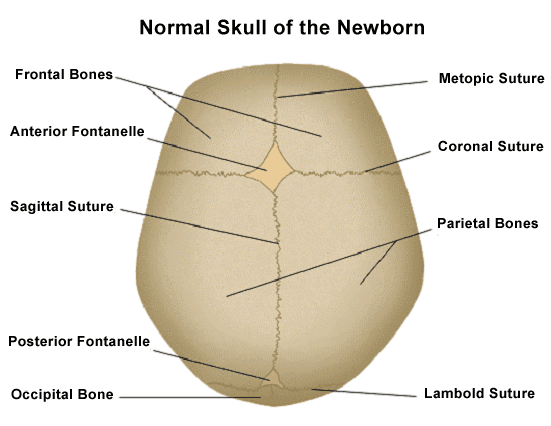What is Craniosynostosis?
So, here is the basic rundown. The skull is not actually one solid piece at birth, it's not meant to be at least. There are 4 major sutures (an immovable junction between two bones, such as those of the skull) of the cranium. Here's a picture of a normal Skull of a newborn baby.

As you can see, there are 4 major sutures. Metopic, Coronal, Lamboid and Sagittal. These sutures are meant are meant to be open at birth. As the brain grows, it pushes out the skull and the head begins to grow. However, sometimes one or more of these sutures fuse prematurely and don't allow the head to grow properly. Best case scenario, it will only be a cosmetic issue. Worst case scenario, this can cause intra cranial pressure and put stress on the brain and cause complications and even death. Let's take a look at each one.
Sagittal Craniosynostosis
The premature fusing of the sagittal suture causes scaphocephaly (elongation of the head), while the widest part of the head, the lateral axis (above the ears) is abnormally narrow. The back of the head will be narrower than the front. Often, there is bossing (protruding) of the forehead, and the occiput in the back sticks out, causing a bulge.
Coronal Craniosynostosis
Coronal synostosis may occur on one side (unicoronal), or on both sides (bicoronal). For bicoronal synostosis, the child's head will be wide and shallow. For unicoronal, the forehead on the side of the fused suture will flatten, and the eye on that side will be raised when compared to the other. Often, bicoronal synostosis is syndromic, but not exclusively.
Metopic Craniosynostosis
Metopic craniosynostosis affects the middle area of the babies head, from the nose to the fontanel (soft spot). This causes trigonocephaly, resulting in a pointed forehead. The eyes are closer than normal.
Lamboid Craniosynostosis
The most rare form of craniosynostosis, lamboid may be hard to distinguish from positional plagiocephaly. Premature closure of the lambdoid suture causes flattening of the back of the head on the side where the suture has fused. The ear on the flattening side is farther back than the other, and the mastoid area (bone behind the ear) is bulged.
